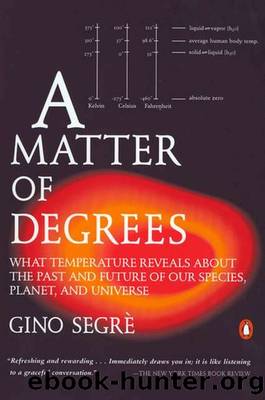A Matter of Degrees: What Temperature Reveals About the Past and Future of Our Species, Planet, and U Niverse by Gino Segre

Author:Gino Segre [Segre, Gino]
Language: eng
Format: epub
Tags: Biophysics, Life Sciences, Mechanics, Non-Fiction, Physics, Science, Thermodynamics
ISBN: 9781101640173
Google: u5PgWW4SEkEC
Amazon: B00AFZI7LE
Publisher: Penguin Books
Published: 2003-06-30T23:00:00+00:00
Some Like It Hot
The tubeworms living on the hydrothermal vents were definitely a surprise. So were the bacteria. They should all have been dead at vent temperatures. After all, that’s why meat and chicken are cooked to 160 degrees Fahrenheit: to kill the bacteria. The father of modern microbiology and of the germ theory of disease, Louis Pasteur, had emphasized over and over again the importance of sterilization by heating. Proving that spoilage was caused by the arrival of microorganisms, not by their spontaneous generation, he showed how heating prevented the damage. Living by his own philosophy, “There is no such thing as pure and applied science—there is only science, and the applications of science,” Pasteur wrote treatises, complete with diagrams and photographs, showing how to preserve quality by heating wine, beer, milk, cheese, or cider. He helped design equipment to warm fluids in large quantities at low cost. His name and his work are immortalized by the common word pasteurization. Yet bacteria on the vents are thriving at 170 degrees or higher. What does it mean?
Thermophilic microorganisms living on Smokers have some close sea-level relatives found in hot springs. These places are similar in many ways to the ocean-bottom hydrothermal vents. Wherever water has seeped down to molten rock, it can bubble back up to the surface as a stream or a geyser. It depends on the opening. That opening may be a volcano or a peephole. The crust may have a crevice or a crack, may lie on the ocean bottom or on a mountaintop, and the manifestation may be lava or steam. When underground heat emerges on the ocean bottom or on the surface, we have what geologists call a “hot spot.”
One of the most familiar “hot spots” is Yellowstone National Park’s “Old Faithful” geyser in Wyoming. During the course of a long-term 1960s study of microbial life in Yellowstone’s hot springs, Thomas Brock and his colleagues found a new kind of bacterium flourishing at 160 degrees. They called it Thermus aquaticus. Brock’s group coined the term thermophile to distinguish these bacteria from the “normal” kind, with tolerance to 150 degrees set as the threshold for membership in the new and presumably rare class.
The scientists certainly weren’t looking to discover many more thermophiles on land, much less on the ocean bottom. But shortly after Thermus’s identification, the same team found Sulfobolus acidocaldarius in an acidic spring at 185 degrees. To distinguish this bacterium from thermophiles, the team chose the name hyperthermophile. At that point Brock asked, What was the ultimate limit? Were there going to be superhyperthermophiles? How hot did it have to get before life became truly untenable?
The prerequisites for life anywhere in the solar system and possibly the universe are threefold. The first is an energy source capable of driving the chemical reactions that lead to life; the second is the presence of organic molecules that carry genetic information; the third is water. Liquid water is a sine qua non, the solvent and the medium for the chemical reactions.
Download
This site does not store any files on its server. We only index and link to content provided by other sites. Please contact the content providers to delete copyright contents if any and email us, we'll remove relevant links or contents immediately.
| Cell Biology | Developmental Biology |
| Entomology | Marine Biology |
| Microbiology | Molecular Biology |
| Biostatistics |
Sapiens: A Brief History of Humankind by Yuval Noah Harari(13035)
The Tidewater Tales by John Barth(12025)
Do No Harm Stories of Life, Death and Brain Surgery by Henry Marsh(6332)
Mastermind: How to Think Like Sherlock Holmes by Maria Konnikova(6220)
The Thirst by Nesbo Jo(5777)
Why We Sleep: Unlocking the Power of Sleep and Dreams by Matthew Walker(5636)
Sapiens by Yuval Noah Harari(4528)
Life 3.0: Being Human in the Age of Artificial Intelligence by Tegmark Max(4491)
The Longevity Diet by Valter Longo(4441)
The Rules Do Not Apply by Ariel Levy(3897)
The Immortal Life of Henrietta Lacks by Rebecca Skloot(3818)
The Body: A Guide for Occupants by Bill Bryson(3788)
Why We Sleep by Matthew Walker(3767)
Animal Frequency by Melissa Alvarez(3749)
Yoga Anatomy by Kaminoff Leslie(3696)
Barron's AP Biology by Goldberg M.S. Deborah T(3626)
The Hacking of the American Mind by Robert H. Lustig(3575)
All Creatures Great and Small by James Herriot(3506)
Yoga Anatomy by Leslie Kaminoff & Amy Matthews(3391)
